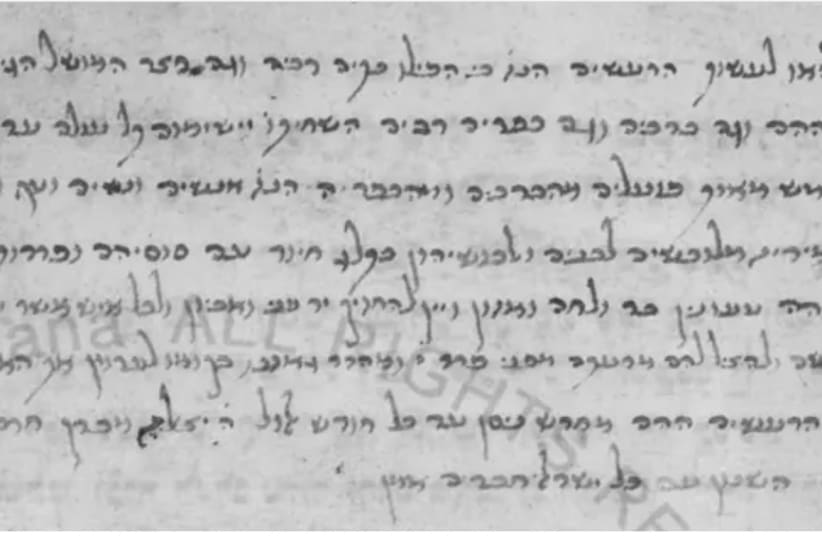The serendipitous discovery of a note written in a 15th century Hebrew prayer book fills an important gap in the historical Italian earthquake record. The discovery provides a brief glimpse of a previously unknown earthquake affecting the Marche region in the central Apennines.
While looking for contemporaneous accounts of another historic Italian earthquake, ecologist Paolo Galli – who found the note in the Apostolic Vatican Library – writes in Seismological Research Letters that the note “not only helps us partially fill a gap in the seismic history of Italy but also prompts us to reflect on how we still do not know about seismogenesis [the generation of an earthquake] even in times covered by written sources.”
The Apennines is the second main mountain range of Italy that stretches for hundreds of kilometers from the north to the south along the central spine of the country. Large beech forests, many of which are centuries-old and probably among the oldest in Europe, cover the mountain slopes in many areas. The mountain range has a rich diversity of ecosystems and wildlife, beech trees, open hillsides and alpine grasslands.
The findings were published in Seismological Research Letters under the intriguing title “All the People of Israel Are Friends: An Unknown Mid-Fifteenth Century Earthquake in the Marche Region Recorded in a Coeval Hebrew Manuscript.”
“The wealth of historical sources in Italy is undoubtedly one of the richest, but it is equally subject to gaps both in terms of time and in places,” said Galli. “Unlike the Kingdom of Naples, for example, the production of documentation related to earthquakes has certainly been poorer in the Papal States, of which the Marche Region was a part in the 15th century.”
The note discovered by Galli was written on the leaf of the prayer book that had been copied in the Marche town of Camerino and completed in September and October 1446. The eight lines of the note describe an earthquake around Camerino that destroyed houses, the governor’s courtyard, and cities and villages “that have become a mound of stone.”
Men and women “come here in Camerino dressed in white pale dresses with their horses and mules and donkeys loaded with bread and food and wine, in order to hold the hand of the poor,” the note continues, while stating that the earthquakes in the area continued from March to September.
Descriptions of the damage
The note is the only evidence of a damaging earthquake in the Marche region from the 15th century. Galli said a 1446 request for funds to restore city walls and a castle in Petrino (a settlement 20 kms. away from Camerino) may be the only other possible written indication of a damaging earthquake in the region.
There are only 450 documented earthquake site observations from Italy in the 15th century, and about half of those come from a key historic earthquake sequence in 1456 in the south-central Apennines. Galli had been looking through the library’s manuscripts from the Middle Ages to find more information about this sequence when he came across the prayer book.
The earthquakes of 1456 represent the most catastrophic seismic sequence that occurred in the late Middle Ages in central-southern Italy, he explained. “Despite the abundance of historical sources, particularly a specific treatise on the earthquake written by the famous humanist Giannozzo Manetti, we still do not have certainties about the different epicentral areas and, therefore, the parameters of individual mainshocks – magnitude and epicenter – and their seismic sources.”
The damage described in the prayer book suggests that Camerino may have experienced intense shaking, measuring about an 8.0 on the Mercalli-Cancani-Sieberg intensity scale, Galli continued. This level implies severe damage and partial collapse to half of the town’s buildings, along with the fall of columns, monuments and walls. Galli suggested the Camerino earthquake might have been a “twin” to a 1799 sequence in the region, where a magnitude 6.2 earthquake caused similar intense shaking.
“Of course, this is only a hypothesis, but by comparing the epicentral area and the level of damage in Camerino and its surroundings, it is possible that the effects described in our manuscript describe, albeit briefly, something similar to the event of 1799,” Galli noted.
“In particular, the manuscript mentions that many settlements around Camerino were reduced to piles of stones, indicating that the epicentral area was possibly the same as in 1799,” he added. “Similarly, the absence of information in the far field suggests that the earthquake was likely caused by a shallow-depth fault, as probably occurred in 1799,” he concluded.

